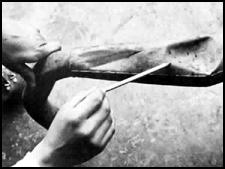|
Funny how things
happen. A reader named Lee Curry asked for some tips on fixing
dented pipes. I thought I had already done that article some years
back, but when I did a search on ORC for it, there was nothing to be
found. So I checked out my vast library and found just what was
need. So Lee, here you are.
Even though modern
bikes have high pipes, the head pipe and belly are especially vulnerable
to dents in a simple fall, or if you ride over a fallen bike. Then,
the head pipe can get squashed almost flat.
Low pipes on vintage
bikes leave you with mixed feelings. Sure, it's nice to have the pipe
out of the way, allowing plenty of room for a spacious air box and never
having to worry about burning your legs, but it sure isn't any fun when
those pipes get all crunched up - which is most of the time. We don't
care how well your low pipe is tucked in, that hunk of tubing will get
more than its share of dings, dents and reshaping.
Generally, if the
head pipe and first cone are in good shape, the output of the engine
won't suffer too much. The belly of the pipe and the second cone can
take some pretty ugly dents with out affecting performance too much
The tips shown here
are easy and effective ways to get that pipe back to its normal contours.
Some people we know like to heat a dent up and "blow" the pipe back to
its original shape with the aid of an air compressor, but we'd suggest
that you avoid this. The possibilities of getting splattered with hot
metal are too great.
The final hint. If
you keep dinging up the same area repeatedly, then by all means put some
additional protection over the area. Small pieces of angle iron make for
good protection, especially for the area where the head pipe joins the
first cone. Flat strap metal is good for the belly, second cone and
joining the stinger to the final cone.
You can also
"read" pipe damages to detect other faults in your bike. If the head
pipe separates from the first cone for no apparent reason, you might have
a cracked frame or loose motor mounts. If the pipe breaks at the rear
hanger, you could have loose or worn hardware in the swingarm pivot. Check
it out carefully.

Here
you have the more or less normal dents any pipe tends to
accumulate. |

Mark
some lines on the opposite side of the pipe that correspond with
the dent. |

Drill
evenly spaced holes the length of the dent. Try not to make them
too big; just enough to allow a rigid piece of metal to get in. |

Tap
a blunt instrument (we have an old broken screwdriver with ground
down ends) against the dent while it's laying solidly against
the floor. Tap lightly and evenly through all of the holes,
feeling for high spots and making them level. |

Done
properly, the metal will assume its original shape. |

The
holes must then be filled in. Run a bead around the hole until it
keeps getting smaller and smaller. |

If
you don't want to drill holes through your pipe, then try the
attach-and-pry method. Braze an old bolt in the middle of the ding
and attach a nut to the threads. Then heat the entire outer area
with the largest tip you have. |

Pull
gently when the metal is cherry red and keep working from the
opposite side of the heat. When the dent is out, torch off the
bolt and file everything smooth. |
|
|
|